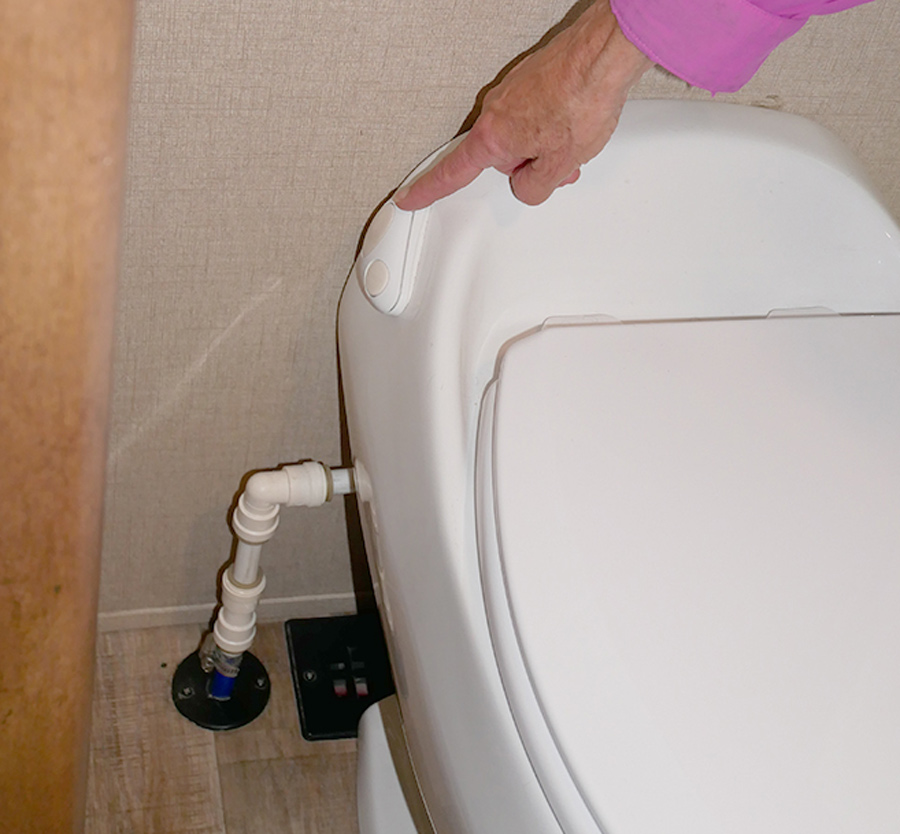Subscriber Access Only
Special Offer
Get 1 year of RV Enthusiast Magazine for just $9.99
Unlock My Offer No ThanksAlready a subscriber? Click here to access full issues.

Alice Zealy channeled her sense of aesthetics and design into a growing RV renovation business. We took a look at a few of her recent transformations — from stock RVs to custom cruisers — and convinced her to offer up a number of tips she’s learned along the way for the do-it-yourselfer considering adding more personal touches than can be purchased on the Internet.
Garden-type showers really spiff up any bathroom, so removing the curved glass shower enclosure may seem like a step backward to some. We were tired of endless water spots and stuck tracks, though, and found a designer shower curtain not only makes cleanup a snap but improved spaciousness. It was also a great time to deal with cracks in the shower pan.
We first installed a Dometic 320 toilet within days of taking delivery of our fifth wheel, replacing a smaller and less-comfortable model. Full-time use pushed its limits, though, especially when it came to valve seal integrity. In its place, we recently opted for a Thetford Aria Deluxe II for its forceful flushing cycles. And because we like to push buttons.
Living in an RV full-time with a small bathroom sink and little counter space takes a good sense of humor. Still, it was tough to laugh off the way we had to route power cords (also known as dirt magnets) when using things like hairdryers and electric toothbrushes. Fortunately, concealing them wasn’t a big job, though it makes a vastly improved appearance.
Anyone who’s ever suffered through an earthquake knows full well what happens: things break. It shouldn’t come as a surprise, then, when a component finally fails on an RV. The only problem lies in tracking down a replacement — or, better still, an upgraded replacement. Want to know what’s available? Here’s a look at nearly three dozen of the top new products you’ll want this year for your RV.
Most fifth-wheel hitches are heavy and bulky, which makes removal impractical between trips unless you have a forklift, hoist or neighbor willing to help. Pullrite’s 50-pound SuperLite hitch not only streamlines the process but also makes hooking up a breeze. Did we tell you it allows for hitch height to be set at three levels — or that it has a whopping 20,000-pound weight rating?
If you use propane to fuel your grill and fire pit, you’re probably tired of lugging around those disposable cannisters. In fact, you probably longed for an exterior propane connection that allows you to use gas from the RV’s main supply. Well, stop wishing. If your RV didn’t come so equipped from the factory, you can install an exterior connection yourself in a few minutes with the right parts and a few simple hand tools.
(805) 320-6909
[email protected]
EDITOR – Bruce Hampson
(574) 584-4616
[email protected]
TECHNICAL DIRECTOR
BILL GEHR
(805) 340-5015
[email protected]
ART DIRECTOR – MIKE ACCUARDI
[email protected]
26362 Douglas ave., Elkhart, in 46514
 AFFILIATE NOTICE: RVE Media Group LLC provides links to vendors and products, such as an Amazon Associates account, for informational purposes, but that may provide a commission if you purchase from that link. We often label these links with language that provides transparency if the destination is an advertiser, affiliate, or partner. Products are often provided to RVE at little/no cost for editorial testing purposes by vendors/suppliers. Under no circumstances does this affect the results of the test or install as published in RV Enthusiast. Sponsored content is identified as such directly on the content.
AFFILIATE NOTICE: RVE Media Group LLC provides links to vendors and products, such as an Amazon Associates account, for informational purposes, but that may provide a commission if you purchase from that link. We often label these links with language that provides transparency if the destination is an advertiser, affiliate, or partner. Products are often provided to RVE at little/no cost for editorial testing purposes by vendors/suppliers. Under no circumstances does this affect the results of the test or install as published in RV Enthusiast. Sponsored content is identified as such directly on the content.
PRIVACY POLICY: Our complete privacy policy can be found at https://rventhusiast.com/privacy-policy/
By Bob Livingston
As RVs Evolve, OEMs Need to Mitigate Common Problems
raveling in an RV throughout the peak summer months is always an eye-opener. Spending time among RV owners puts the lifestyle into prospective and, frankly, it’s a great learning experience. There is no doubt that times are changing and the dynamics of RVing are evolving with new owners — including many younger people — offering a fresh viewpoint on social interactions and enthusiasm for the rigs themselves.
To us RV veterans with, well, a “few decades” under our belts, it’s fun to compare how RVers participated in the lifestyle in the early days versus those of today. Although clothing trends, hair styles and the RVs are dramatically different, not much has changed when it comes to sitting under a patio awning, enjoying a plate of potluck offerings and schmoozing with fellow RVers.
But that is where any similarity ends.
Who could have predicted, for example, the reality of pulling travel trailers with electric tow vehicles — or communicating via satellites circling the planet? When the phone rings while sitting around the propane-fueled fire, I simply raise my arm and talk into my watch. (I can see the smile on Dick Tracy’s face.) During one of my stays in an RV park in the Pacific Northwest, I ran into a fellow camper who was towing his 30-foot Airstream with a shiny new Rivian all-electric truck. It was quite the combo, offering a lot of pizzaz to RV ownership; going for a test ride was certainly exhilarating.






News & Notes

At late January’s RV SuperShow in Tampa, Florida, Keystone RV was set to debut a new floorplan in its popular Montana fifth wheel brand that’s sure to resonate with anyone who needs to juggle work commitments with play. The Montana 3941FO (for Front Office) combines the best of both worlds, placing a well-equipped office space in the upper deck — right behind the Montana’s huge panoramic window.
Keystone has built the Montana in a number of iterations — including the popular front kitchen — and this one should find a ready audience, as well.
Check Your Bearings

I’ve been told that the wheel bearing in my trailer axles should be checked annually or after 12,000 miles of travel. My trailer has Nev-R-Lube bearings, which are supposed to be sealed and not needing inspections. What would you do?
— Maryann Fisher
The Nev-R-Lube bearings from Dexter are sealed and do not need to be repacked with grease. Still, you should pull the wheels and inspect the spindles/bearings for adverse wear every year or 12,000 miles, as stated by Dexter. You’ll be looking for endplay, adverse wear and possible leaking grease. Although these bearings are sealed, they are not infallible and can leak. If that happens, you’ll need to replace them. Annual inspections also allow you to check for adverse brake wear and any wiring problems.
If you have standard bearings, it’s imperative that they are inspected and repacked yearly (or 12,000 miles, whichever comes first). Unfortunately, most bearings are made overseas and tend to wear quickly or even fail. You don’t want to be stuck on the road with a bearing failure, which can result in expensive repairs and collateral damage. Make it a habit to pull the bearings yearly and check for worn splines, which can become loose and even sloppy. When repacking, use high-quality, disc brake grease and always replace the grease seals.


f you’ve somehow missed it, RV interior design is all the rage these days. Virtually every major RV manufacturer has an interior designer or two on staff — and for those that don’t, suppliers such as Lippert and Patrick Industries have founded design studios to assist builders in the fabrication of a more custom “look” to RV living quarters. These designers go to the same home shows, subscribe to the same magazines and speak to the same trend-setters and product suppliers as the people responsible for the extraordinary rooms photographed for the covers of those magazines.
Their task is at once both seemingly simple and arduous — identifying upcoming trends in brick-and-mortar homes and adapting them to a mobile lifestyle.
It’s not easy to do when you’re only working with about 400 square feet of living space, but their limited success — underscored to an extent, perhaps, by the popularity of current “farmhouse” interiors which jettison “traditional” wood tones for light colors — is evident on every RV dealership lot across North America. “Residential style” has, in fits and starts, been a years-long cornerstone of RV interior designers when choosing everything from colors and fabrics to backsplashes and faucets.

V renovation is all the rage these days and many people are transforming older rigs, looking to restore or upgrade the vintage experience — but it’s not just about older rigs. There are two ways to look at RV renovation: re-working the interior or a portion thereof for a new look or making changes to improve livability and function. That old adage about putting money into the kitchen and bathroom of a brick-and-mortar home to reap the best bang for the bucks holds just as true for mobile living. In my case, the bathroom in the fifth wheel my wife, Lynne, and I live in full time just wasn’t cutting it any longer — and it was difficult to clean and maintain. It was time for a make-over to improve function — and the new look and feel were just icing on the cake.
Initially, the main target was the curvy garden-type shower stall with glass doors. This type of shower stall is stylish, but cleaning is a nightmare. Copious amounts of crud built up around and under the shower-door track and its wheels barely moved because of corrosion from hard water. We cleaned the bottom portion of the enclosure regularly but doing so required back-breaking scrubbing while getting into all the nooks and crannies around the wheels and track; a thorough cleaning was almost impossible. The decision was made to chuck the original enclosure and replace it with a shower curtain.


Although the bathroom was quite compact, the Dometic 320 toilet and original shower stall seemed to co-exist in the limited footprint. The new shower curtain actually extends a little closer to the new Thetford Aria Deluxe II toilet (which was next on our “to-do” list), but when it’s pulled open there’s much more elbowroom.
arden-type showers really spiff up any bathroom, adding an element of luxury to an otherwise nondescript room in an RV (unless, of course, you have a high-end rig). The curved doors provide additional elbowroom and keep stray water from the showerhead and splashing off your body under control. While everything seemed copasetic, cleaning was difficult, the door track wheels were sticking and the ugly build-up of crud that was impossible to reach grated on my psyche. Still, I was almost traumatized with the thought of yanking out the shower-door panels and replacing them with a shower curtain. How uncool to go back to a shower curtain, right?
It was a great decision.
Complicating the project were the cracks that developed over the years (my rig is a 2015 model) in the shower pan through which water was leaking into the storage compartment and on the ground. Leaking water is evil, leading to expensive damage via rotting wood if not dealt with.

o RV can be considered self-contained without a bathroom — and, of course, a toilet. Unless you’re into potty humor, a toilet is one of those “things” that most owners take for granted; they only serve one purpose and are usually not top of mind until they break. The trend is to have a toilet that emulates those found in stationary homes, with preferences for porcelain and residential-type seats. These days, there are myriad toilets on the market for RVs, including those with electric- and/or vacuum-flushing mechanisms and Americans with Disabilities Act (ADA) height compliance. For the most part, the majority of RV toilets have foot pedals for flushing and are made of plastic or porcelain. Nothing terribly exotic.
We first installed a Dometic 320 in our fifth wheel only days after delivery, replacing a smaller model that was less comfortable. It’s a good toilet, albeit the flushing stream a little anemic, but that wood seat was a game changer. While it provided decent service, full-time use pushed its limits, especially when it came to valve seal integrity. It was time for an upgrade.
We chose the Thetford Aria Deluxe II for its forceful — and complete — flushing cycles and because pushing a button has a certain appeal for those who enjoy automatic features and, frankly, like pushing buttons. The company’s big selling point is the ability to push the button and walk away, allowing the mechanism to complete the flushing cycle. And it works fabulously.

iving in a fifth wheel full time with a small sink and little counter space takes a good sense of humor. Fortunately, the designers of this model were pretty clever, providing a huge storage cabinet and adjacent shelves to house most of the toiletries without being disheveled. Add in the large wood medicine cabinet above the sink — with a mirror, of course — and the facilities are workable with acclimation.
Every square inch of counter space is needed, so placing the charging stands for the cordless toothbrushes behind the sink made the most sense. For years, the power cords were routed along the wall to the power outlet at the end of the counter; stick-on covers were used to “conceal” the wires, but they just collected dirt and were terribly unsightly. A simple fix was to drill a hole near the charging bases and route the wires under the counter and up through another hole near the 120-volt AC power outlet. The wires were ganged and connected to a new plug for connection to one side of the outlet.



nyone who has ever suffered through an earthquake knows full well what happens to a home when the ground shakes.
Things break.
It shouldn’t come as a surprise, then, when a component on an RV ultimately breaks down. While RV equipment tends to be more robust than its land-locked counterpart, such parts and accessories aren’t infallible — especially when subjected to the earthquake-like shaking created by untold miles of rutted, cracked and potholed roadways.
Fortunately, replacements exist for virtually anything RV-related — and, even better, the past few years has seen a huge increase in new-and-improved components as technology continues to bridge the gap between products used in brick-and-mortar houses and those integrated into traveling homes.

owing fifth-wheel trailers is popular for several reasons — not the least of which is the inherent stability when on the road. Then, too, there’s the ease of hooking up without having to handle/store heavy pieces of hitch equipment. To reap the benefits, however, a fifth wheel hitch must be installed in the bed of the truck and usually occupies a big chunk of the bed space. It’s also a heavy and bulky piece of equipment, making it difficult to remove when additional bed space is needed.
Fifth wheel hitches typically have a saddle with a latching mechanism that accepts (and locks) the kingpin built into a box mounted on the front of the trailer. While this approach is certainly tried and true, PullRite (pullrite.com), a builder of high-quality conventional saddle-style fifth wheel hitches, also offers an alternative, the SuperLite, which takes the sting out of removing and installing heavy, bulky hardware while focusing a completely different approach to hooking up.

ropane, also known as LP-gas, is the fuel of the RV lifestyle. It oftentimes provides us with conveniences like hot water, a stove, a refrigerator and a furnace and also can fuel exterior appliances like grills, barbecues and fire pits. The popularity of factory-installed exterior propane connections and even complete exterior kitchens provide additional convenience for those who enjoy cooking and entertaining outdoors — but what if your RV has neither?
Of course, you can still fuel your outdoor gas appliance(s) with disposable propane cannisters, but these take up space in the exterior storage compartments — and if you run out, you’ll have to take the party back indoors, take a trip to the local store or borrow a cannister from a friendly neighbor.
If any of these scenarios are familiar, you’ve probably longed for an exterior propane connection that allows you to use gas from the RV’s main supply — either the propane tank in a motorhome or the propane cylinders in a travel trailer or fifth wheel. Stop wishing. If your RV didn’t come so equipped from the factory, you can install an exterior connection yourself in a few minutes with the right parts and a few simple hand tools. Cost for this project was a little more than $100.


























